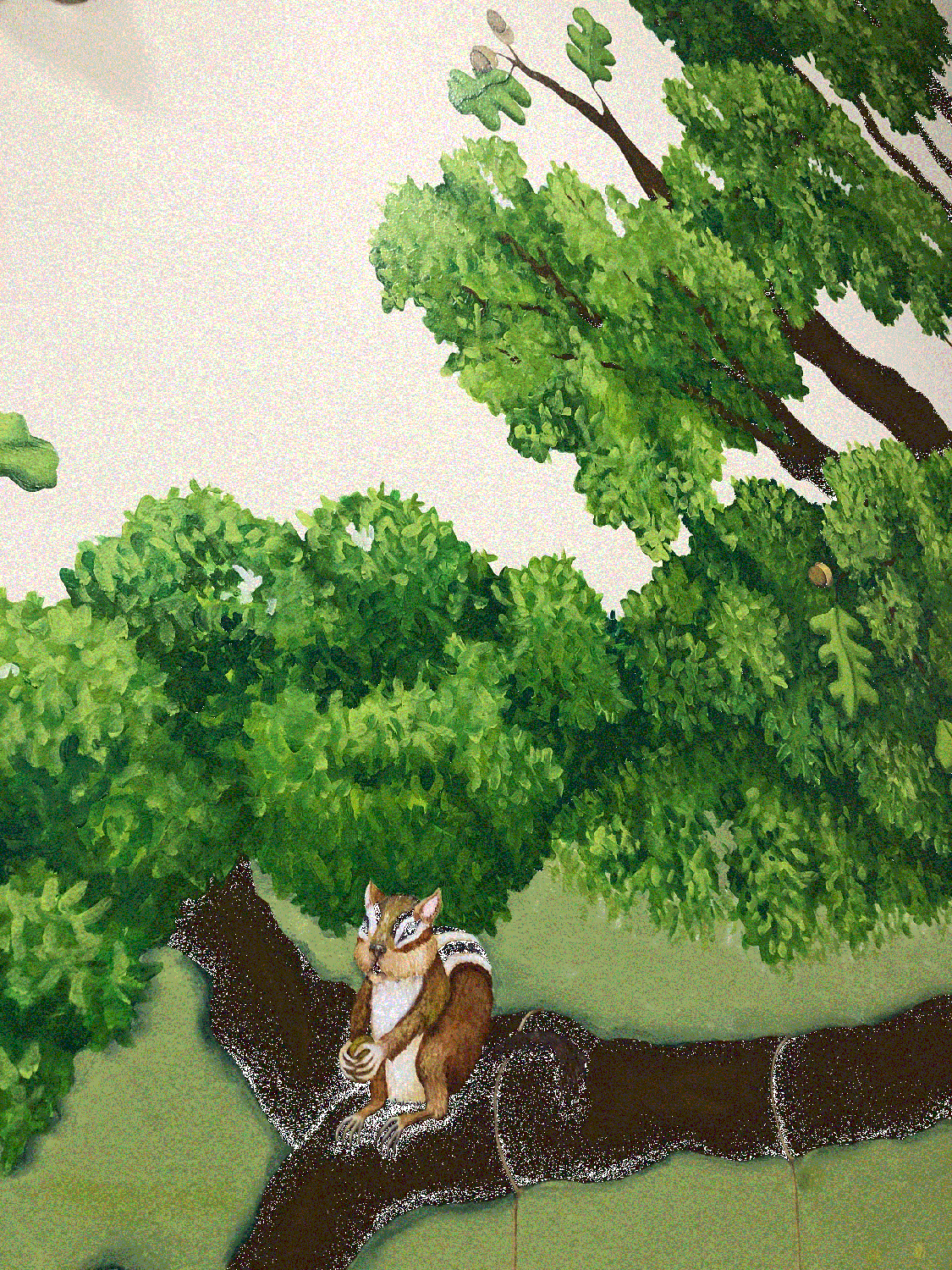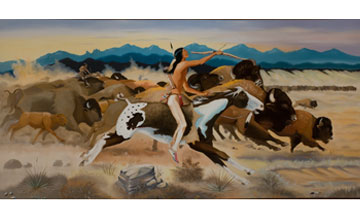![]()
|
The Library owns an extensive art collection, assembled over the years. The pieces, located throughout the Library, include paintings, sculptures, and murals, many of which were donated by patrons. Take a tour of the Library's art here or during your next visit to the Library. The Library gratefully acknowledges the funding and assistance provided by the Highland Park Cultural Arts Commission for this project. |
Frank Charles Peyraud (Swiss/American 1858-1948)
View of the Skokie, 1931
Oil on canvas mounted on wall
74 x 102 in.
Frank Peyraud was born in Bulle, Switzerland. In 1881, he immigrated to Chicago, and lived in the Ravinia area of Highland Park from 1919 until his death in 1948. He was a student of the Art Institute of Chicago and the renowned École des Beaux-Arts, Paris. Peyraud earned a lasting reputation for rural landscapes, especially snow scenes in broadly defined forms and glowing colors. He was one of the first American painters to focus on Midwestern landscape and received numerous awards from the Art Institute of Chicago. Peyraud was known to many as the “dean of Chicago landscape artists” and the Lakeview Museum of Arts and Sciences titled their 1985 catalogue of his work as such. Peyraud died just before his ninetieth birthday.
This work was commissioned for the new library building and installed in August 1931. The Skokie was a marshland located west of Highland Park.
Rudolph Frank Ingerle (American, b. Austria, 1879-1950)
Moonlight on Lake Michigan, 1931
Oil on canvas
74 x 102 in.
This painting was commissioned for the new Library building and was installed in August of 1931.
Rudolph Ingerle was born in Vienna, Austria and immigrated to the United States when he was 12. He studied at John Francis Smith’s Art Academy and at The School of The Art Institute of Chicago (1891). He is most noted for his plein-air landscape paintings and travelled extensively in search of landscapes that appealed to him. His work has been exhibited at the Art Institute of Chicago and other museums and galleries. Art critic Eleanor Jewitt had this to say about Rudolph Ingerle, “He paints landscapes like poems. Ingerle pours beauty on a canvas as though it were a rich wine. No one can handle sun and shadows as he does.”
Rudolph Ingerle settled in Highland Park in 1922 and lived on Laurel Avenue. He was active in the community and an ardent supporter of the Library, serving on the Library Board of Trustees in the late 1930s and early 1940s. Ingerle’s work is in the collection of the Art Institute of Chicago, The Union League Club of Chicago, and the Illinois State Museum, Springfield, among other places. He died in Highland Park in 1950.
Walter Koeniger (American, b. Germany, 1881-1943)
Winter Scene, date unknown
Oil on canvas mounted
35 x 37 in.
Walter Koeniger was born in Germany and came to the United States around 1910. He became a member of the Woodstock, New York, artists’ colony in 1912. Koeninger lived in New York’s Catskill Mountains and spent his thirty-year career sketching and painting frozen water scenes around his home. He is known for his paintings of snow-covered landscapes and used fresh, glowing colors to convey the crisp, vigorous mood of his settings.
Frederick William Boulton (American, 1904-1969)
Waiting for the 8:18, date unknown
Oil on Masonite
25 ¼ x 32 1/8 in.
Gift of Mr. and Mrs. Arthur F. Marquette, 1953
Frederick William Boulton was born in Mishawaka, Indiana. He studied at the Art Institute of Chicago and the American Academy, as well as the Académie Julian, Paris. From 1938-1959 he lived in the Braeside area of Highland Park on Pine Point Drive. He was a painter, and an illustrator, and also worked as a general craftsman who showed at venues such as the Pennsylvania Academy of Fine Arts and the Highland Park Women’s Club. Boulton was an art director and vice-president at the advertising agency J. Walter Thompson Co., Chicago.
Photo by Michael Tropea
 Beth Shadur (American, b. 1954)
Beth Shadur (American, b. 1954)
Nature Mural, 2006
Acrylic mural
100 x 54 in.
Beth Shadur, a Highland Park artist and Artist-in-Education for the Illinois Arts Council, has created over 125 large murals as public, private and community art projects in the United States and Great Britain. She has exhibited widely in the United States and abroad. Her work has been exhibited at the Art Institute of Chicago and other museums across the country and is included in many private and public collections.
This mural, located at the entrance of the Youth Services Department, was commissioned to announce the renovation of the Youth Services Department in 2006.

Harbor Seal
Bronze
12 x 18 x 10 in.
Gift to the Library in memory of Helen Kuh Kuhns, 1962
Sylvia Shaw Judson grew up in Lake Forest and was the daughter of well-known architect Howard Van Doren Shaw and the poet Frances (Wells) Shaw. Judson studied at The School of the Art Institute in Chicago on and off between 1915 and 1918 and later in Paris at the Académie de la Grande Chaumière. Her works have been exhibited in museums, at Chicago’s Century of Progress Exposition (1933), and at the New York World’s Fair (1939). Shaw’s work can be found in the collection of the White House, in the offices of the President of the Philippines, and at the Massachusetts State House.
Sylvia Shaw Judson received much posthumous attention in the late 1990s when her Bird Girl sculpture (1938) appeared on the cover of the book “Midnight in the Garden of Good and Evil,” by John Berendt. The sculpture also appeared in the opening scene of the movie with the same title.
Harbor Seal is located outside the Library’s lower level entrance, in the courtyard pool. The sculpture was donated to the Library in memory of Helen Kuh Kuhns, a former president of the Library Board of Trustees.
Sylvia Shaw Judson (American, 1897-1978)
The Reader, 1946/1961
(Variant title: Boy Reading, source: “For Gardens and Other Places; The Sculpture of Sylvia Shaw Judson,” by Sylvia Shaw Judson)
Bronze
24 ½ x 17 ½ x 18 in.
Gift of the Marjorie and Richard Ettlinger and Laurie and Alan Reinstien families in memory of Viola and Lawrence Stien and Ruth and Bernard Nath
Sylvia Shaw Judson grew up in Lake Forest and was the daughter of well-known architect Howard Van Doren Shaw and the poet Frances (Wells) Shaw. Judson studied at The School of the Art Institute in Chicago on and off between 1915 and 1918 and later in Paris at the Académie de la Grande Chaumière. Her works have been exhibited in museums, at Chicago’s Century of Progress Exposition (1933), and at the New York World’s Fair (1939). Shaw’s work can be found in the collection of the White House, in the offices of the President of the Philippines, and at the Massachusetts State House.
Sylvia Shaw Judson received much posthumous attention in the late 1990s when her Bird Girl sculpture (1938) appeared on the cover of the book “Midnight in the Garden of Good and Evil,” by John Berendt. The sculpture also appeared in the opening scene of the movie with the same title.
The Reader is the first sculpture patrons approach when entering the Library. It is one of the most familiar and loved works of art in the Library, and a magnet to the younger set of library users.
Joseph Burlini (American, 20th Century)
Clown on Unicycle
Stainless steel with polychrome enamels
84 x 30 in. diameter
Joseph Burlini, a Chicago-area sculptor, creates pieces for public and private spaces. His work is in the collections of The Pentagon and the Chicago Botanic Garden. Burlini’s style ranges from abstract to representational. Wheels are a common theme of his works, which are designed for motion. Burlini has numerous public sculptures in the region, including Balance Machines (Lincoln Mall in Matteson, Illinois) and Circus City (The Aon Center, Chicago).
William Keating (American, b. 1932)
Sky Lark, 1978
Welded and Polished Aluminum
111 ½ x 40 in. diameter
Gift of Mr. and Mrs. Stanley L. Harris and the Illinois Arts Council
William (Bill) Keating is a self-taught artist from Northbrook, Illinois who specializes in hand-formed welded aluminum. Keating originally worked in advertising, but changed his direction mid-career and became a sculptor in 1973. Keating’s work is part of the collections of the Palatine, Illinois Public Library, Standard Oil of Indiana and the Oakton Sculpture Park in Des Plaines, Illinois. In a 1976 documentary about Keating, the artist described his works as “an abstract view of his sense of balance with nature.” He said, “I see metal as part of nature, coming raw from the earth, then refined by man. I strive to bring it back to nature by treating it as part of earth to be formed and managed.” The title of this kinetic sculpture was chosen as a metaphor for the human search for knowledge.

Paha Ska (Oglala Lakota, 1923-2005)
Sioux Buffalo Hunt, 1978
Oil on canvas
47 ¼ x 97 ½ in.
Gift of Joan and Bud Towne, The Squash Blossom Gallery
Paha Ska was a contemporary Oglala Lakota artist and a member of the Ogalla Sioux tribe. He resided in Keystone, South Dakota, for nearly 50 years. Paha Ska means “White Hills” in English. Ska is a self-taught artist who attempted to portray an Indian way of life in his work.